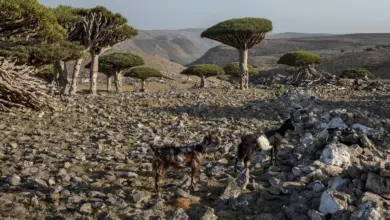Camera in hand, the natural beauty of Gharb Soheil all around her–and with environmental preservation, of course, in mind–Hoda Baraka shoots a set of boldly vibrant photographs. She uses color and composition to capture a village’s striking beauty, all the while communicating the necessity of preserving it.
“From Gharb Soheil” is sponsored by the Center for Environment and Development for the Arab Region and Europe (CEDARE). Egyptian artist Mohamed Abla, ever passionate about environmental sustainability and the concept of merging art with environmental causes, inaugurated the exhibit on 5 July.
On one side of the gallery, birds stand among grass, looking regal. Natural light delicately illuminates the strands of grass and hay. From the far wall, Nubian men stare back at you, their faces creased yet peaceful, exemplifying the village’s vitality. Doorways and windows in striking orange and turquoise remind one of a box of crayons.
Baraka possesses “an interest in doors and windows in general, and these ones in particular symbolize the doorway into the people and place of Gharb Soheil.”
Despite Baraka’s inspiring photos, however, she isn’t pursuing a career in photography. “My true aspiration is to use photography as a medium for environmental advocacy,” she says. This isn’t only the artist’s first photography exhibition, but also her first attempt to raise environmental awareness through the medium of art.
Gharb Soheil is a village in the Upper Egyptian province of Aswan. Due to its rich Nubian culture and unrivaled scenery, it has been slated as a tourist destination, where travelers can spend a day exploring Nubian society. Local residents, though, want to maintain their village precisely as it is: a simple town unblemished by large-scale, commercial tourism, which can pose a serious threat to local ecosystems and environments.
“The people of Gharb Soheil are campaigning against unsustainable development, which would endanger their habitat,” says Baraka.
While vacationing in this village of some 2000 inhabitants, Baraka became enthralled with its beauty, realizing it was the perfect starting point for pursuing her dreams of “activist photography.”
By capturing the village’s transcendental beauty on film, she brings to light the splendid immensity of what is potentially under threat. “What we lose, we can never regain,” says Baraka.
She goes on to recall how a Nubian friend from the village had poignantly mourned the loss of several local species of bird. “He told me how he had grown up seeing certain birds, which are nowhere to be found today,” she remembers.
Color is the predominate theme of this exhibit. Baraka recalls with a chuckle how she had thought about entitling the exhibition “something quite clichéd, like ‘Colors of Gharb Soheil’.” Baraka intended her exhibit to carry artistic images rather than “dry photography.”
“I’m not giving plain facts; I’m conveying beauty, and showing the threat of losing such a magical place,” she says.
Through colorful photographs of the village’s architecture, inhabitants, landscape and wildlife, the photographer attempts to depict a village that she found to be “full of life and color.”
The candid portraits on the wall give the villagers a voice. “I wanted to bring out the essence of these men; convey their spiritual and wholesome natures,” Baraka says. The photographs reveal faces marked by tranquility and reflection.
Two of Baraka’s Gharb Soheil photographs were chosen by the Youth Ministry to be shown at the annual Youth Salon exhibit, in which artwork by budding Egyptian artists is showcased.
Overlooking a busy street in Cairo’s cosmopolitan Maadi district, the assortment of photographs provides the viewer with a refreshing dose of crisp color. The exhibition will run until 29 July.




